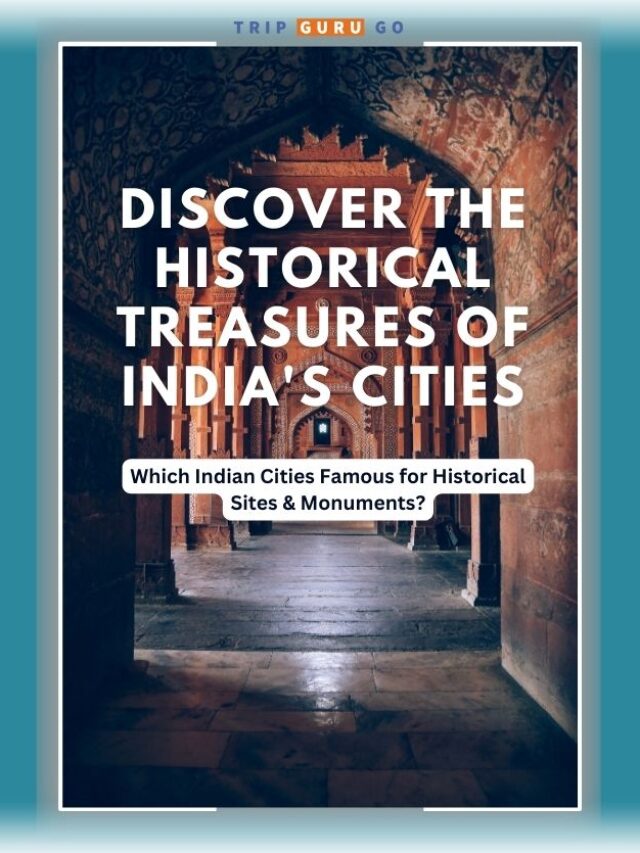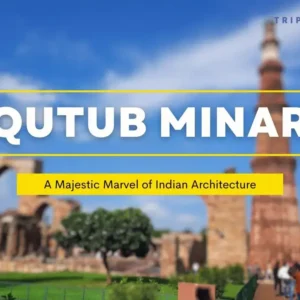Introduction
India, a country steeped in history, boasts an unparalleled wealth of cultural heritage and famous Historical Sites and Monuments in India that stand as a testament to its rich past. From ancient forts and palaces to intricate temples and tombs, India offers a captivating journey back in time. This article serves as an Introduction to historical places in India 2024, exploring some of the most famous historical places in India known for their historical significance. This allows travelers and history enthusiasts to embark on a remarkable exploration of the country’s glorious past.
Historical Significance of India
India’s historical significance spans millennia, encompassing ancient civilizations like the Indus Valley, the profound influence of the Vedic period, the grandeur of the Maurya and Gupta empires, the opulence of the Mughal dynasty, and the transformative era of British colonial rule. Reasons to visit India lie in exploring this rich tapestry that has shaped its vibrant cultural identity today.
Visiting awe-inspiring Famous Historical Places in India, like the majestic Taj Mahal, the ancient ruins of Hampi, the intricately carved temples of Khajuraho, and the spiritual aura of Varanasi, offers a captivating journey through time. Experience India’s rich heritage, warm hospitality, and flavorful cuisine, blending ancient traditions with modernity for an unforgettable travel experience. Explore Historical Places in India with names and immerse yourself in the stories they hold.
Agra: Iconic Taj Mahal and Historical Monuments in India
Undoubtedly one of the most recognizable landmarks in the world, the Taj Mahal in Agra stands as a symbol of famous Historical Sites and Monuments in India, eternal love, and architectural brilliance. Built by Emperor Shah Jahan in memory of his beloved wife, Mumtaz Mahal, this ivory-white marble mausoleum exudes magnificence and grandeur.
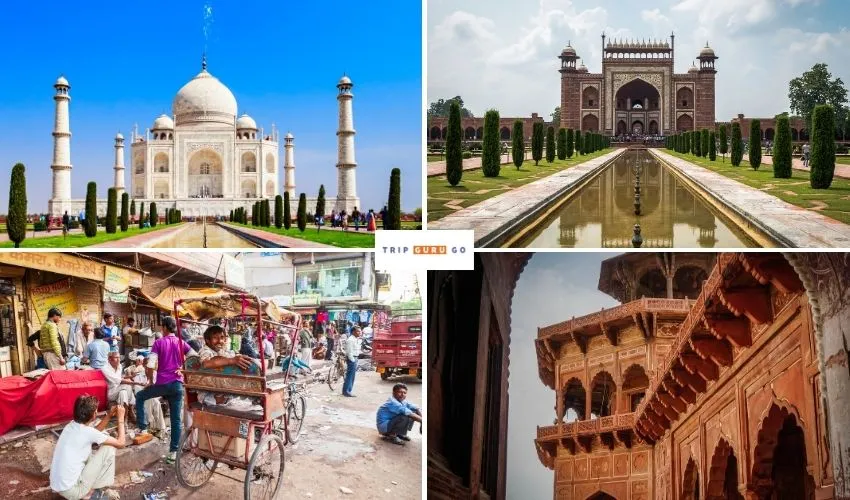
The History of the Taj Mahal
The history of the Taj Mahal dates back to the 17th century when Shah Jahan commissioned its construction. Skilled artisans and craftsmen from various parts of the world labored for over two decades to bring the vision of this breathtaking monument to life.
Architectural Marvel of the Mughal Empire
The Taj Mahal is an exquisite example of Mughal architecture, blending Islamic, Persian, Indian, and Turkish design elements seamlessly. Its perfectly symmetrical layout, intricate carvings, and lush gardens leave visitors in awe of its beauty.
A Symbol of Love and Devotion
Beyond its architectural brilliance, the Taj Mahal represents a poignant love story. This masterpiece immortalizes the emperor’s deep love for his wife, making it a place of romance and reflection.
Delhi: The Capital Steeped in History
As the capital city of India, Delhi boasts a fascinating history spanning over several centuries. It served as the center of various dynasties, leaving behind a treasure trove of famous Historical Sites and Monuments in India. It has been a witness to the rise and fall of various empires, leaving behind a rich tapestry of historical landmarks and cultural heritage. Join us as we embark on a journey through Delhi’s past, exploring the fascinating tales that have shaped this vibrant and diverse metropolis.
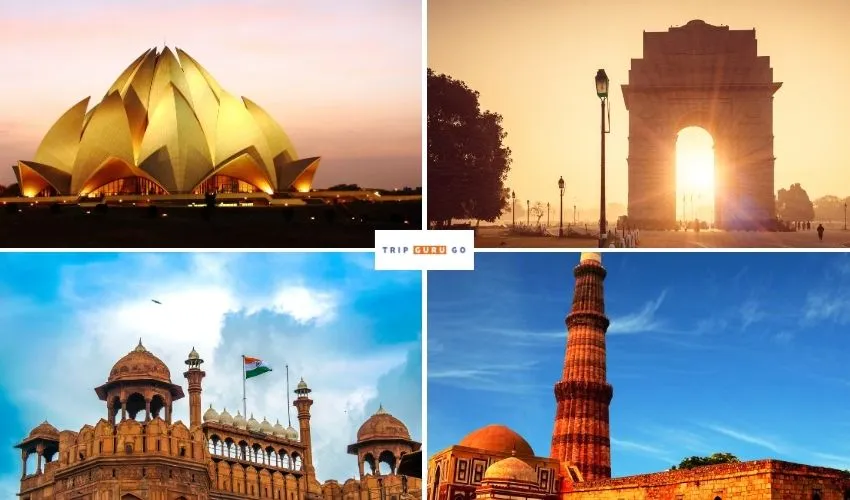
The Rich Heritage of Delhi
Delhi’s heritage includes remnants from the Mughal, Sultanate, and British eras, making it a melting pot of cultures and architectural styles. Exploring the Red Fort is an enchanting journey into India’s rich history. This iconic monument in Delhi showcases stunning Mughal architecture and holds tales of bygone empires within its walls.
Exploring the Red Fort
The iconic Red Fort, a UNESCO World Heritage Site, stands as a symbol of India’s struggle for independence. Its imposing red sandstone walls enclose a series of splendid palaces and gardens.
Qutub Minar – A Tower of Victory
Another architectural marvel in Delhi is the Qutub Minar, a towering minaret built by Qutb-ud-din Aibak. This five-story structure is adorned with intricate carvings and verses from the Quran. Qutub Minar, a towering victory monument in Delhi, India, is a UNESCO World Heritage Site, showcasing stunning Indo-Islamic architecture and historical significance.
Jaipur: The Pink City with Majestic Forts
The Pink City, Jaipur, earned its name due to its distinctive pink-hued buildings. Tourists admire this city for its majestic forts and palaces. Jaipur, also known as the Pink City, is a captivating destination in India, renowned for its Historical Sites and Monuments. The city’s stunning architecture, characterized by its pink-colored buildings, reflects its rich historical heritage. Tourists flock to iconic landmarks such as Amber Fort, Nahargarh Fort, and City Palace, immersing themselves in the city’s regal charm.

Amber Fort – The Grandeur of Rajasthan
Amber Fort, situated on a hilltop, offers stunning panoramic views of the surrounding landscape. Its intricate architecture, incredible mirror work, and ornate halls are a testament to the opulence of Rajput rulers. Amber Fort, a majestic fortress in Rajasthan, India, showcases the grandeur of Rajput architecture with its impressive palaces, intricate designs, and breathtaking hilltop views.
City Palace – Where Royalty Resides
The City Palace in Jaipur is a sprawling complex that houses a museum, gardens, and courtyards. It provides a glimpse into the lavish lifestyle of the royal families of Rajasthan. City Palace, a majestic complex, exudes royal splendor in India. Residing within its walls are opulent courtyards, grand halls, and museums that showcase the rich heritage and history of royalty.
Varanasi: The Spiritual City
One of the oldest living cities in the world and a prominent spiritual center in India is Varanasi, also known as Kashi. Varanasi, often called the spiritual heart of India, is a captivating city with a rich history dating back thousands of years. Nestled along the sacred Ganges River, Khajuraho is famous for its ancient temples, mesmerizing ghats, and vibrant spiritual atmosphere. Pilgrims flock here to seek blessings and immerse in its mystical charm.

The Oldest Living City in the World
Varanasi has a history that stretches back thousands of years, making it one of the most sacred cities for Hindus.
Ghats of Varanasi – A Spiritual Experience
The ghats along the Ganges River are central to the spiritual experience in Varanasi. The ritualistic ceremonies and boat rides during sunrise and sunset offer a deeply enriching experience. Varanasi’s Ghats offer a profound spiritual experience, where pilgrims flock to bathe in the sacred Ganges River, witness mesmerizing rituals, and immerse in the city’s rich cultural tapestry.
Khajuraho: Sensual Temples & Historical Sites in India
The group of temples in Khajuraho, India, features intricate and erotic sculptures. Khajuraho, a UNESCO World Heritage site, is one of the famous Historical Sites and Monuments in India, preserving exquisitely carved temples dating back to the Chandela dynasty (around 950 to 1050 AD). These temples showcase intricate sculptures that depict various aspects of life, celebrating human emotions and relationships.

The Intricate Temple Carvings
The temples of Khajuraho feature elaborate carvings depicting various aspects of life, including dance, music, and divine deities.
The Symbolism Behind the Erotic Art
The erotic sculptures, although attention-grabbing, serve as a symbol of fertility and divine energy in ancient Indian art.
Hampi: Exploring India’s Ruined Kingdom and Historical Sites
The prosperous capital of the Vijayanagara Empire was once Hampi, a UNESCO World Heritage Site. Hampi, located in Karnataka, India, is a captivating UNESCO World Heritage Site that showcases the remnants of a once-magnificent Vijayanagara Empire. The ruined kingdom boasts awe-inspiring architecture, ancient temples, majestic pillars, and intricate carvings that transport visitors back in time. Hampi’s historical significance and surreal landscapes make it one of the must-visit famous Historical Sites and Monuments in India.

The Magnificent Ruins of the Vijayanagara Empire
The ruins of Hampi scatter across a vast area and comprise impressive temples, royal complexes, and marketplaces.
Hampi – A UNESCO World Heritage Site
Recognized for its historical and architectural significance, Hampi draws history enthusiasts and backpackers alike. Hampi, a UNESCO World Heritage Site in India, is an ancient city with remarkable ruins and monuments that showcase the rich history and architectural brilliance of the Vijayanagara Empire.
Fatehpur Sikri: The Abandoned City
Emperor Akbar constructed Fatehpur Sikri, an awe-inspiring city near Agra, India, in the 16th century. Renowned for its stunning Mughal architecture and intricate craftsmanship, the city served as the imperial capital for a short-lived period. Although abandoned later, its majestic palaces, mosques, and courtyards continue to captivate visitors today.

Akbar’s Visionary Capital
Emperor Akbar constructed Fatehpur Sikri, an awe-inspiring city near Agra, India, in the 16th century. It served as the Mughal capital for a short period, showcasing exquisite architectural marvels.
The Mystery of Its Desertion
Water scarcity led to the abandonment of Fatehpur Sikri, freezing behind a hauntingly beautiful city in time despite its grandeur.
Mamallapuram: The Marvelous Rock-cut Temples
Mamallapuram, also known as Mahabalipuram, attracts fame for its stunning rock-cut temples and monuments. This is a captivating coastal town in Tamil Nadu, India. Renowned for its exquisite rock-cut temples and monuments, it showcases remarkable craftsmanship dating back to the 7th century. The UNESCO World Heritage site features impressive structures like the Shore Temple and Arjuna’s Penance, attracting history enthusiasts worldwide.

The Pallava Architecture
The temples at Mamallapuram showcase the brilliance of Pallava architecture, with intricate carvings and sculptures. The ancient South Indian style of architecture, Pallava architecture, features intricately carved rock-cut temples and monolithic structures, which showcase notable Dravidian influences and exquisite craftsmanship.
The Shore Temple and Other Monuments
Overlooking the Bay of Bengal, the Shore Temple is a testament to ancient India’s artistic achievements. This UNESCO World Heritage site in Mahabalipuram, India, showcases a remarkable example of ancient Dravidian architecture, along with other captivating monuments nearby.
Hyderabad: The Nizam’s Legacy and Historical Sites and Monuments in India
The city of Hyderabad in Telangana has a rich history that has been shaped by the Nizams. This legacy still resonates in the city today. Hyderabad, located in southern India, boasts a rich history and cultural heritage. It is known for the influence of the Nizams, who ruled the region for many centuries. The city’s history is evident in its splendid monuments, palaces, and forts, such as the Charminar, Golconda Fort, and Chowmohalla Palace. These sites are famous historical places in India, showcasing the cultural charm and architectural marvels that continue to captivate visitors. Hyderabad’s connection to the Nizams adds to its significance among famous Indian sites.

Golconda Fort – A Historical Gem
The Qutb Shahi dynasty used the majestic Golconda Fort as their capital and earned renown for its ingenious acoustic design. Golconda Fort, an iconic historical gem in India, boasts impressive architecture and a rich past. It stands as a testament to the country’s glorious history and attracts visitors from around the world.
Charminar – An Iconic Landmark
Charminar, a monument and mosque, is a symbol of Hyderabad and a popular tourist destination. The magnificent historical structure, Charminar, located in Hyderabad, India, attracts visitors from all over the world with its four grand arches and intricate Islamic architecture. It is known for its iconic landmark status.
Kolkata: A Melting Pot of Cultures
The cultural capital of India, with its history and intellectualism, is a city steeped in Kolkata. A vibrant capital of West Bengal, blending diverse cultures, captivates all who visit. Known as the “City of Joy,” it showcases a rich tapestry of traditions, art, and literature. From its colonial-era architecture to bustling bazaars and delectable cuisine, Kolkata offers a unique and enriching experience for every visitor. Amidst this cultural extravaganza, Kolkata also stands as one of the famous historical places in India, boasting a connection to the country’s heritage and past. Its significance contributes to the array of famous Indian sites that travelers admire and explore.

Victoria Memorial – A British Remnant
The magnificent Victoria Memorial is a tribute to Queen Victoria and a reflection of the colonial era. The Victoria Memorial is a British-era monument located in Kolkata, India. It stands as a remnant of the colonial past, showcasing exquisite architecture and historical significance.
Howrah Bridge – An Engineering Marvel
The iconic Howrah Bridge, connecting Kolkata to Howrah, is a testimony to Indian engineering prowess. Howrah Bridge, an engineering marvel in Kolkata, India, is an iconic cantilever bridge spanning the Hooghly River, known for its unique design and historical significance.
Mysore: The City of Palaces
Renowned for its regal heritage and opulent palaces, Mysore, located in Karnataka, India, is often hailed as the “City of Palaces.” It boasts a rich history and is home to famous Historical Sites and Monuments in India, including opulent palaces like the iconic Mysore Palace, a grand masterpiece adorned with intricate architecture and captivating artwork. The city’s regal charm, cultural heritage, and majestic landmarks draw visitors from around the world.

Mysore Palace – A Royal Residence
The Mysore Palace, an architectural marvel, reflects the grandeur of the Wodeyar dynasty. Mysore Palace, an opulent royal residence in Karnataka, India, showcases exquisite architecture and rich history. It is a symbol of grandeur and cultural heritage.
Brindavan Gardens – Where Nature Meets Architecture
The Brindavan Gardens, with its musical fountains, offer a delightful experience for visitors. A harmonious blend of nature and architecture, where stunning landscapes and meticulously crafted designs come together to create a captivating and serene environment.
Gwalior: The Fort City
Known as the “Fort City,” Gwalior, located in Madhya Pradesh, boasts imposing forts and palaces, making it a historically significant destination in India. Its crowning glory is the majestic Gwalior Fort, an architectural marvel perched atop a rocky hill. The fort’s imposing structures, intricate carvings, and captivating history draw visitors from across the world, solidifying its place among the famous historical places in India. Gwalior’s heritage-rich ambiance enthralls history enthusiasts and travelers alike, offering a glimpse into the grandeur of famous Indian sites.
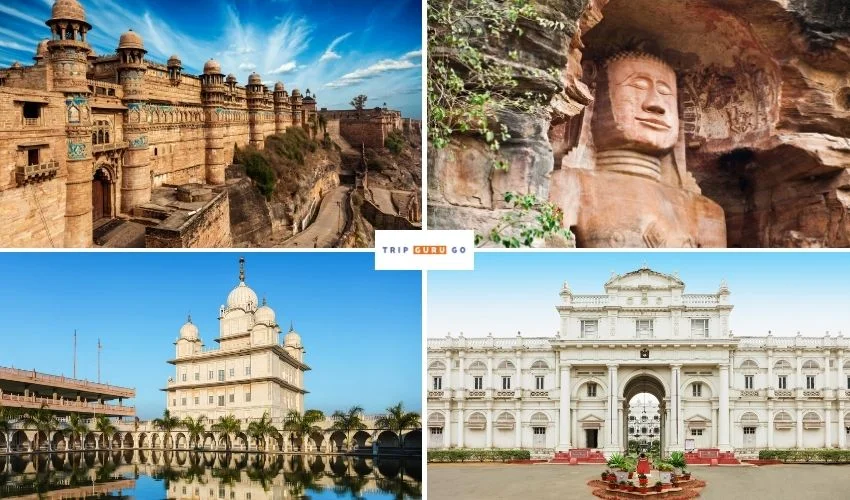
Gwalior Fort – A Testimony to History
The Gwalior Fort stands as a witness to the bravery and valor of several rulers. A historical testimony, an iconic landmark reflecting India’s rich past. Its grandeur and significance make it a captivating destination for history enthusiasts and tourists alike.
Scindia Museum – A Glimpse into the Past
The Scindia Museum within the fort complex houses a remarkable collection of artifacts and royal memorabilia. Scindia Museum offers a captivating glimpse into the past, showcasing a rich collection of historical artifacts and treasures, providing a unique experience of India’s heritage.
Conclusion
In conclusion, India is a treasure trove of famous historical places and monuments that offer a glimpse into its illustrious past. Each city mentioned in this article holds its unique charm, architectural brilliance, and historical significance. Exploring these cities is not only a journey through history but also an opportunity to experience the diverse cultural heritage of India. From the iconic Taj Mahal in Agra to the majestic Amber Fort in Jaipur, these famous Indian sites are a testament to the rich history and cultural tapestry of the nation.
FAQs
Yes, most of these historical sites are well-maintained and protected by the authorities to preserve their cultural and architectural significance
Agra is well-connected to Delhi by road and rail. You can take a train, or bus, or hire a cab to reach Agra from Delhi.
Yes, photography is allowed in most of these historical sites. However, there might be restrictions in some specific areas.
Yes, there is an entry fee for most historical sites. The fee varies for Indian and foreign tourists.
The winter season (October to March) is generally the best time to visit India for historical sightseeing, as the weather is pleasant and comfortable for travel.


